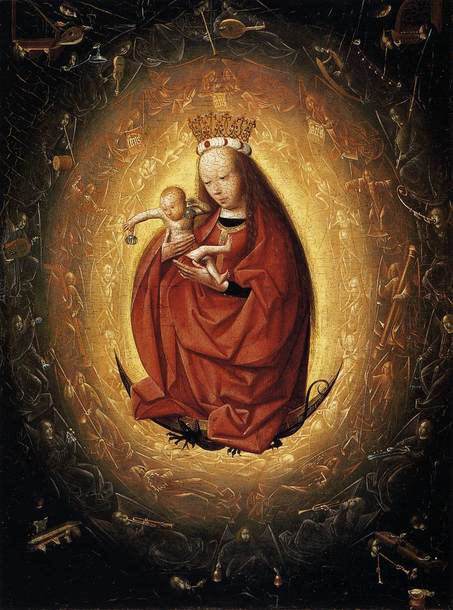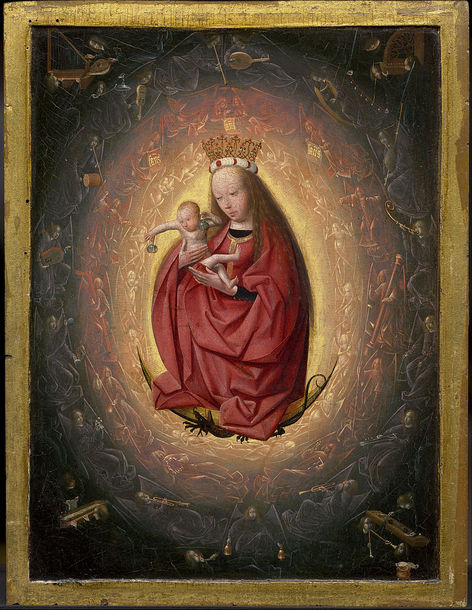聖母マリアが踏みつけるものたち(1) Those Whom the Virgin Mary Treads (1) [ひまつぶし]
だいぶ前の記事――
「大天使ミカエルのこと The Archangel Michael」 のあとの「大天使ミカエルが踏みつぶすものたち(1) Those Whom the Archangel Michael Treads (1) [ひまつぶし] 」に連動しています。
奏楽天使を探っているとき〔2014年の春〕に遭遇した(知っていた絵だったけれども、踏みつけはあんまり意識していなかったか、無意識のうちに閉じ込めてしまった)絵。
以前の記事では、「大天使ミカエルの図像は、いろいろなものを踏みつけにする姿を描いているものが多いです」と書いたけれど、実のところ、龍(dragon)=蛇(serpent)=魔王(Satan)≒悪魔≒おっさん、ということで、同一なのでした。
ミカエルは、失楽園の堕天使物語にも終末論の最後の審判にも闘う者として登場する武闘派天使ですから、悪魔を踏みつけにするイメジが多いのは納得するんですけど、女子でもあったのね。

Geertgen tot Sint Jans (c. 1465-c. 1495), De verheerlijking van Maria [The Glorification of the Virgin; also, Madonna with Musical Angels ] (c. 1490-95) Museum Boijmans Van Beuningen, Rotterdam image via Web Gallery of Art
ヘールトヘン・トット・シント・ヤンスは初期フランドル派の画家で、写本挿絵画家としても活躍した人。この絵は24cm×18㎝ (上の画像では落ちている金色の枠を足して26×20cm)の小さな板絵のようです。「ヨハネ黙示録」に由来するとされる三日月 (Crescent) の上の聖母像というモティーフなのだけれど、奏楽の天使たちが(天球)層 (sphere) 状に回っています。
シント・ヤンスは Saint John で、聖ヨハネ騎士団に属していたことからこの呼称(「聖ヨハネの小ヘールトヘン」)があるみたい。他に、地名をとって 「ヘールトヘン・ファン・ハールレム Geertgen van Haarlem」とか。ヘールトヘンは英語だと Gerald で、レオナルド・ダ・ヴィンチをレオナルドじゃなくてダ・ヴィンチと呼ぶのがズレている以上に、シント・ヤンスと呼ぶのはズレているかもしれません。日本ではこの絵は『ロザリオの聖母』と呼ばれているようですが、聖母の頭の冠の白・赤のバラが5個・1個のくりかえしでロザリオをあらわしている。
なんか、考えたことは後に書くことにして、ウィキペディアにある画像を貼っておきます。――
中の額縁がいつの製造かわからないですけど、どうやら外して撮ったらしい画像もあります。――
これのオリジナル――Original file (7,758 × 10,025 pixels, file size: 20.38 MB, MIME type: image/jpeg) <https://upload.wikimedia.org/wikipedia/commons/6/6a/Geertgen_tot_Sint_Jans_-_The_Glorification_of_the_Virgin_-_Google_Art_Project.jpg>
///////////////////////////
The Glorification of the Virgin 1490 - 1495, Geertgen tot Sint Jans Room 05 [Audio and Visual] <http://tour.boijmans.nl/en/3/>
『Mariのページ』「ロザリオの聖母」 <http://www.marinopage.jp/%e3%80%8c%e3%83%ad%e3%82%b6%e3%83%aa%e3%82%aa%e3%81%ae%e8%81%96%e6%af%8d%e3%80%8d-2/> 〔きちんと参照文献を挙げている立派なページ――(1) パトリック・デ・リンク著、神原正明監修、内藤憲吾訳 『西洋名画の読み方〈1〉』 大阪: 創元社 , 2007-06-10; (2) 『オックスフォ-ド西洋美術事典』 佐々木英也著(訳?) 講談社, 1989/06; (3) 高階秀爾監修 『西洋美術史(カラー版)』 美術出版社, 1990-05-20; 『西洋美術館』 小学館, 1999-12-10〕
mmeissen00 さんの『マニアな毎日』「ヘールトヘン・トット・シント・ヤンス そして宗教画入門1」(2008.5.18) <http://blogs.yahoo.co.jp/mmeissen00/53497817.html> 〔自撮りの貴重な画像とすぐれた解説〕
典拠が書いていないけれど、解説的には詳しいflicker の記事――
GEERTGEN tot Sint Jans - Virgin and Child
GEERTGEN tot Sint Jans.
(b. 1460/65, Leiden, d. 1490, Haarlem).
.
Virgin and Child.
1480s.
Tempera on panel, 26,8 x 20,5 cm.
Museum Boijmans Van Beuningen, Rotterdam.
.
This small painting of the Madonna depicts a fragile female figure holding her newborn together with a vanquished dragon. The artist indicates her floating, vision-like quality with the use of fantastic lighting and an army of angels in concentric circles. By arranging the choir of angels in a manner reminiscent of spheres, it is also expressed that the infant Jesus in the centre of the picture is the ruler of the Universe. With a sweeping gesture and a look of concentration, the infant is shaking two bells, as if to be in concert with the angel doing the same thing on the left side of the picture. They are definitely looking at each other, and since they are the only two doing this, the action has special significance: it shows the "conductor" Jesus in the role of the universe's prime mover. Thus the painting clearly expresses a concept formulated by St Thomas Aquinas, according to which Jesus created the harmony of the spheres..
.
In Geertgen's painting the three attributes of Mary (glory, sadness and joy) are represented by angels encircling the Madonna in three rings. The inner circle contains six-winged cherubs and seraphs. The angels of the second circle hold above the head of Mary the early Christian symbols of glorification, scrolls with the word "Sanctus" appearing on them three times. The rest bear the objects associated with the Passion: the cross, the crown of thorns, a spear, nails, a hammer, and a column. The outside circle presents a multitude of musical angels, symbolizing heavenly happiness. Here we can see nearly all of the instruments of the period: lutes, violas, double recorders, trumpets, drums, bells, horns, bagpipes, hurdy-gurdies, etc. The larger keyboard instruments are located in the corners; on the organ we can see the hand-operated bellows. Obviously, the painter did not intend to reproduce the image of a real orchestra, that is why he included instruments which were never used together...




.jpg)

コメント 0